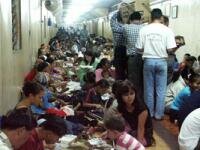




|
A longhouse is rather like a block of terraced houses with many, often closely related, families living under one common roof. The size of a longhouse is determined by the number of doors it has. Each family living in it will have one door, or bilek, opening onto a front corridor. A ten-door longhouse will, thus, have ten families living in it. Rather like a small village except that it is all under one roof.
Bario Asal, the biggest longhouse, is at least three hundred feet long. It has 29 doors, is made mostly of wood and has a zinc roof. The enclosed corridor, or Tawa', which runs along the length of the entire longhouse, is pierced by the doors of each individual home, or bilek. Portraits of the families living in each bilek are usually hung outside their main door. The Tawa' is the focal point of longhouse life.
It is at once a place for relaxation and recreation as well as a children's playground, a council chamber for debating communal matters, a court house even! Family or communal ceremonies are held there. During such functions, there can be well over a thousand people being hosted in that corridor.
A second corridor situated at the back of the longhouse forms an open-plan kitchen area. In between these two corridors lie the enclosed personal living areas for each family. When extra space is required, usually to accommodate a family member starting his own family, the longhouse is extended at one end or another. Bario Asal, having run out of space to expand laterally, has had a few additional rooms added on to either side of the front and kitchen corridors.
Each longhouse has a Headman or Ketua Kampung chosen by longhouse residents, a usual trend being to select someone from one of the leading families. Existing regulations require the selected leader has to have his status formally validated by the District Officer before the appointment becomes final.
Each longhouse also has a small group of residents, either voluntary or selected, to form a village development committee. Other committees are formed when needed to oversee other communal tasks or projects.
3rd March, 2003.
© https://kelabit.net
|
Site Navigation
|
 
|
|

